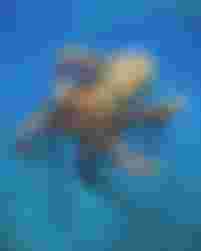Octopuses, an inspiration for monsters throughout history, get a fresh look through a new book that dives deep into the creatures’ mysterious lives.
Octopuses, those whip-smart but bizarre cephalopods, seem to embody everything creepy and mysterious about the sea–the thought of their soft squishy bodies lurking in the oceans’ dark reaches has inspired monsters ranging from the Kraken to the Caribbean Lusca. Their otherworldly forms, heightened by unfurling arms, find their way into more modern monsters and villains too–think Disney’s sea witch Ursula or Spider-Man’s Doc Oc. And don’t forget the octopus-themed horror movies!
A new book, Octopus! The Most Mysterious Creature in the Sea, by Katherine Harmon Courage, comes out today. Harmon Courage takes a deep dive into all things octopus, ranging from their culinary use in dishes around the world to their tragic sex lives. Here, we highlight a few of the fascinating points covered in the book.
1) Octopuses are waaay old. The oldest known octopus fossil belongs to an animal that lived some 296 million years ago, during the Carboniferous period. That specimen belongs to a species named Pohlsepia and is on display at the Field Museum in Chicago. Harmon Courage describes it as a “flattened cow patty” or a “globular splat,” but a close examination reveals the tell-tale eight arms and two eyes. Researchers aren’t sure, but possibly there’s an ink sack there, too. In other words, long before life on land had progressed beyond puny pre-dinosaur reptiles, octopuses had already established their shape for the millions of years to come.

2) Octopuses have three hearts. Two of the hearts work exclusively to move blood beyond the animal’s gills, while the third keeps circulation flowing for the organs. The organ heart actually stops beating when the octopus swims, explaining the species’ penchant for crawling rather than swimming, which exhausts them.
3) The plural of octopus is octopuses. The world “octopus” comes from the Greek, októpus, meaning “eight foot.” The word’s Greek roots means it’s pluralized as a Greek word, too, which depends on both a noun’s gender and the last letter it ends with. In this case, an -es is simply tacked on. So no octopi, octopodes or octopussies, Harmon Courage points out.
4) Aristotle thought octopuses were dumb. In his History of Animals, written in 350 BC, the Greek philosopher wrote that ”The octopus is a stupid creature, for it will approach a man’s hand if it be lowered in the water; but it is neat and thrifty in its habits: that is, it lays up stores in its nest, and, after eating up all that is eatable, it ejects the shells and sheaths of crabs and shell-fish, and the skeletons of little fishes.” After describing a few more quirks of octopus life history–it ejects ink for self-defense, it’s slimy, it can crawl on land–he flippantly signs off, “So much for the mollusca.” However, the big-brained cephalopod can navigate through mazes, solve problems and remember solutions, and take things apart for fun–they even have distinct personalities.5) Octopus arms have a mind of their own. Two-thirds of an octopus’ neurons reside in its arms, not its head. As a result, the arms can problem solve how to open a shellfish while their owners are busy doing something else, like checking out a cave for more edible goodies. The arms can even react after they’ve been completely severed. In one experiment, severed arms jerked away in pain when researchers pinched them.
6) Octopus ink doesn’t just hide the animal. The ink also physically harms enemies. It contains a compound called tyrosinase, which, in humans, helps to control the production of the natural pigment melanin. But when sprayed in a predator’s eyes, tyrosinase causes a blinding irritation. It also garbles creatures’ sense of smell and taste. The defensive concoction is so potent, in fact, that octopuses that do not escape their own ink cloud can die.
7) Octopuses have blue blood. To survive in the deep ocean, octopuses evolved a copper rather than iron-based blood called hemocyanin, which turns its blood blue. This copper base is more efficient at transporting oxygen than hemoglobin when water temperature is very low and not much oxygen is around. But this system also causes them to be extremely sensitive to changes in acidity. If the surrounding water’s pH dips too low, octopuses can’t circulate enough oxygen. Accordingly, researchers worry about what will happen to the animals as a result of climate change-induced ocean acidification.
8) Octopuses, to some, are erotic muses.Japan’s notorious “tentacle erotica” traces back to an 1814 woodblock print (potentially NSFW) titled Tako to Ama, or “Octopus and the Shell Diver.” According to Courage, the image takes inspiration from a legend about a female shell diver who is chased by sea creatures, included octopuses, after attracting the eye of a sea dragon god.
9) After mating, it’s game over for octopuses. Mating and parenthood are brief affairs for octopuses, who die shortly after. The species practices external fertilization. Multiple males either insert their spermatophores directly into a tubular funnel that the female uses to breathe, or else literally hand her the sperm, which she always accepts with one of her right arm (researchers do not know why). Afterwards, males wander off to die. As for the females, they can lay up to 400,000 eggs, which they obsessively guard and tend to. Prioritizing their motherly duties, females stop eating. But she doesn’t starve to death–rather, when the eggs hatch, the female’s body turns on her. Her body undertakes a cascade of cellular suicide, starting from the optic glands and rippling outward through her tissues and organs until she dies.
Editor:Tariq shahzad(Zoologist)
